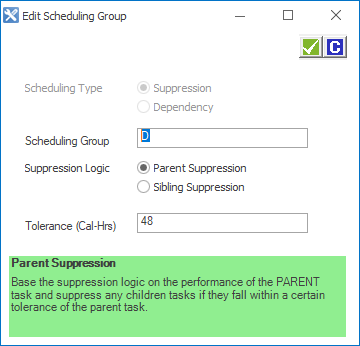Scheduling parameters - Sibling suppression
If you have tasks which are associated with each other, for example, preventive maintenance services or child components of a major component, a form of suppression logic may be appropriate.
Sibling suppression logic is where scheduled occurrences of future tasks are set so that they fall at the scheduled interval (or multiples thereof) after the most recent last occurrence of any projected task in the suppression grouping. This is used primarily for preventive maintenance scheduling where there is a requirement for maintenance to occur at a set scheduling interval. For example:
| Task | First | Frequency | Last Performed | Future Occurrences | ||
|---|---|---|---|---|---|---|
| 500.00.PM.0 | 500 | 500 | 480 | 1480 | ||
| 1000.00.PM.0 | 1000 | 1000 | 980 | |||
| 2000.00.PM.0 | 2000 | 2000 | 1980 | |||
| Scheduling Interval | 500 |
In the above example, future occurrences of tasks within the sibling group are based on the latest last performed task within the group PLUS the scheduling interval (which in this example is set to 500 hours). Calculation summary in order of preventive maintenance:
- PM 500: 480 (actual).
- PM 1000: 480 + 500%= 980.
- PM 500: 980 + 500% = 1480.
- PM 2000: 1480 + 500% = 1980.
% Scheduling Interval = 500
The performance of a parent task resets the life of any children tasks.
Scheduling Intervals for each suppression grouping are maintained in the system table Scheduling Group. Navigate to System Administration > System Tables > Maintenance
